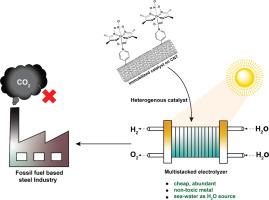钴基分子电催化剂介导的绿色制氢:钢铁工业脱碳的潜在途径
IF 5.6
Q2 ENERGY & FUELS
引用次数: 0
摘要
在气候变化危机中,研究人员正在研究通过可再生能源电解产生的绿色氢气的变革潜力,以实现钢铁行业的去碳化,钢铁行业是全球碳排放的重要贡献者。该项目旨在通过展示绿色氢在生产过程中作为传统化石燃料的清洁替代品的潜力,降低钢铁行业的碳足迹。尽管氢具有潜力,但必须解决成本高、供应受限和基础设施改造等问题。钴基合成催化剂,尤其是钴氧肟,正被视为通过分水制氢的关键电催化元件。钴氧肟在催化氢气进化方面具有高效性和稳定性,在分子催化领域取得了长足的进步。最近,先进的固定化程序显著提高了它们的整体催化产出和应用。本文讨论了几种电解槽技术,如质子交换膜(PEM)和碱性电解,强调了多层电解槽系统在提高制氢效率方面的优势。这些令人鼓舞的成果对于开发出一种耐用的催化材料至关重要,这种催化材料可以在没有太多资金压力的情况下扩大规模。根据全球气候承诺,该文件得出结论,到 2050 年,绿色氢气可满足全球 24% 的能源需求,从而大幅减少二氧化碳排放量。本文章由计算机程序翻译,如有差异,请以英文原文为准。

Cobalt-based molecular electrocatalyst-mediated green hydrogen generation: A potential pathway for decarbonising steel industry
Amid the climate change crisis, researchers are investigating the transformative potential of green hydrogen produced by renewable energy electrolysis to decarbonize the steel sector, a significant contributor to global carbon emissions. It aims to lower the carbon footprint of the steel industry by showcasing green hydrogen's potential as a cleaner substitute for traditional fossil fuels in the production process. Despite its potential, issues such as high costs, restricted availability, and infrastructural alterations must be addressed. Cobalt-based synthetic catalysts, especially cobaloximes, are being considered as a key electrocatalytic component for hydrogen production via water-splitting. Cobaloximes, noted for their efficiency and stability in catalysing hydrogen evolution, have made considerable advances in the field of molecular catalysis. Recently, advanced immobilisation procedures have appreciably enhanced their overall catalytic output and application. This article discusses several electrolyser technologies, such as proton exchange membrane (PEM) and alkaline electrolysis, highlighting the benefits of multi-stacked electrolyser systems for boosting hydrogen generation efficiency. These encouraging results are vital for unravelling a durable catalytic material that can be scaled up without much financial stringency. In light of the global climate pledges, the document concludes that green hydrogen might provide 24 % of the world's energy needs by 2050, resulting in a considerable reduction in CO2 emissions.
求助全文
通过发布文献求助,成功后即可免费获取论文全文。
去求助
来源期刊

Energy and climate change
Global and Planetary Change, Renewable Energy, Sustainability and the Environment, Management, Monitoring, Policy and Law
CiteScore
7.90
自引率
0.00%
发文量
0
 求助内容:
求助内容: 应助结果提醒方式:
应助结果提醒方式:


